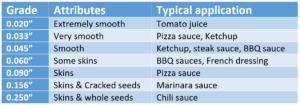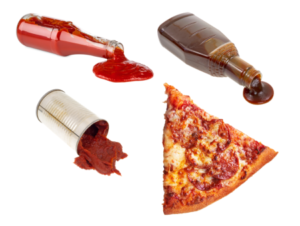How to limit your vulnerability to tomato paste shortages
Written by Colm Swan, former Dressings, Sauces & Condiments Market Manager
When consumers buy tomato paste, they select it based on price, preferred brand, or a combination of both. On an industrial scale however, food manufacturers must also factor in the variety of paste grades that are available. These grades (0.020” to 0.250”) indicate the texture of the final paste and vary significantly in price and availability.
The grade number associated with the paste signifies the size of the mesh or screen the paste has been passed through. This process removes tomato skins and seeds of a certain size. The smaller the number, the finer the paste.

California is the largest producer of tomatoes in the United States, by a lot! 95% of US grown tomatoes come from California where planting takes place from January to early June and harvesting is June through October. With a drought last summer and record low snowpack in the Sierras this winter, tomato crop yields are likely to suffer.
Tomato paste availability will continue to be a concern going into 2023. Manufacturers of ketchup, barbeque sauce and pizza sauces will need to evaluate how lower grade pastes will impact the cost and quality of their products.

So, what can sauce manufacturers do if they are forced to buy lower grade raw material?
Many tomato processors use the Admix Boston Shearmill to refine paste. Sauce manufacturers can utilize this same technology so they can broaden their options when purchasing paste. The Boston Shearmill is used to further refine coarser grade pastes to a grade that is appropriate for their end-product, thus allowing manufacturers to be more flexible and cut costs.
For more information on how this could be implemented into your process, please reach out to Christian Thayer, at cthayer@admix.com or call 802-779-4120..

 Jesper Sæderup Lindeløv, Managing Director
Jesper Sæderup Lindeløv, Managing Director Knud Erik Juhl Jensen, General Manager, Admix Europe ApS
Knud Erik Juhl Jensen, General Manager, Admix Europe ApS
 Patrick Lakin, Director of Sales and Marketing
Patrick Lakin, Director of Sales and Marketing Kara Martakos, Human Resources Director
Kara Martakos, Human Resources Director Keith Cheries, Director of Sales Operations
Keith Cheries, Director of Sales Operations Eric Therriault, Vice President of Engineering
Eric Therriault, Vice President of Engineering Bob Trottier, Vice President of Operations
Bob Trottier, Vice President of Operations Dan Cameron, Chief Financial Officer
Dan Cameron, Chief Financial Officer Mike Rizzo, Chief Executive Officer
Mike Rizzo, Chief Executive Officer